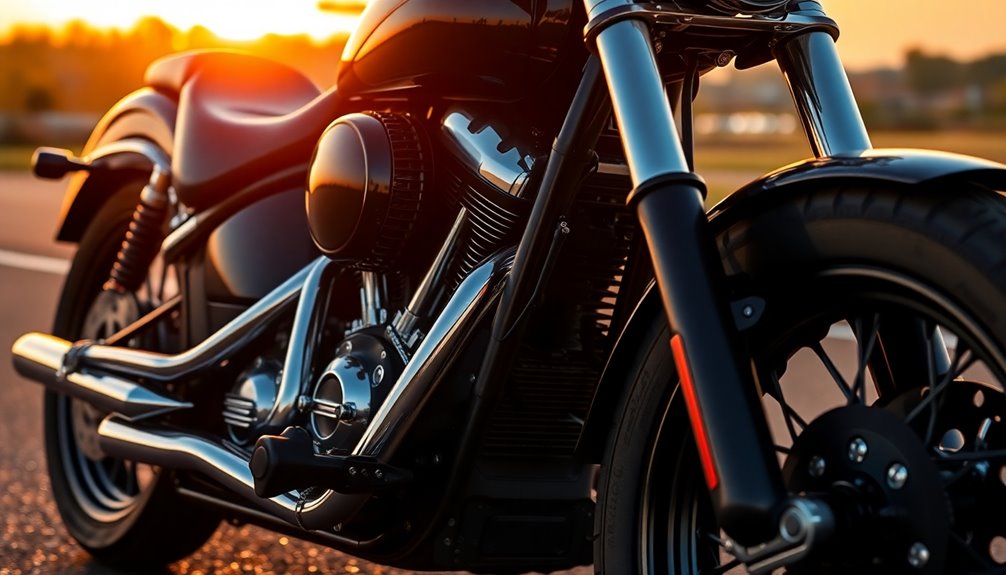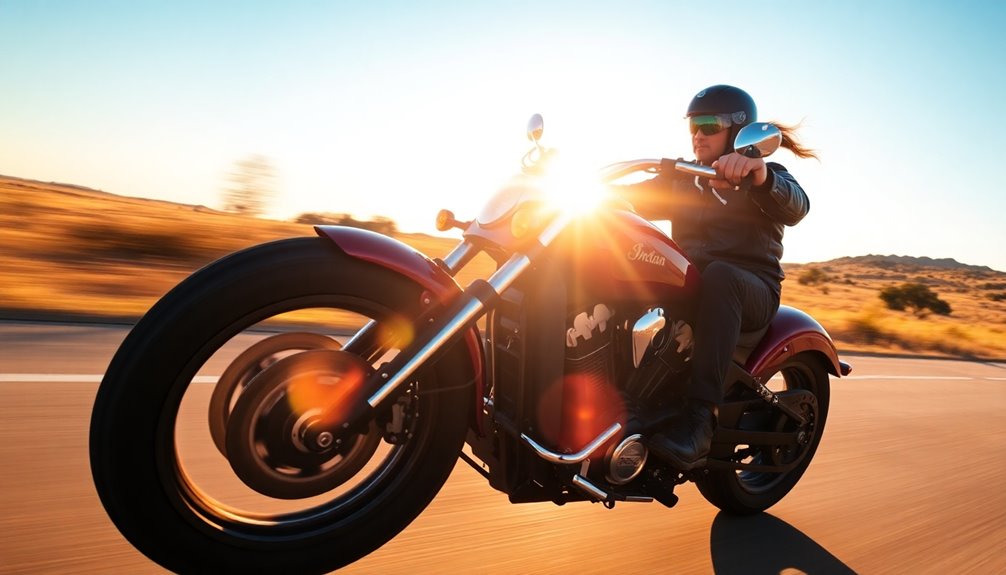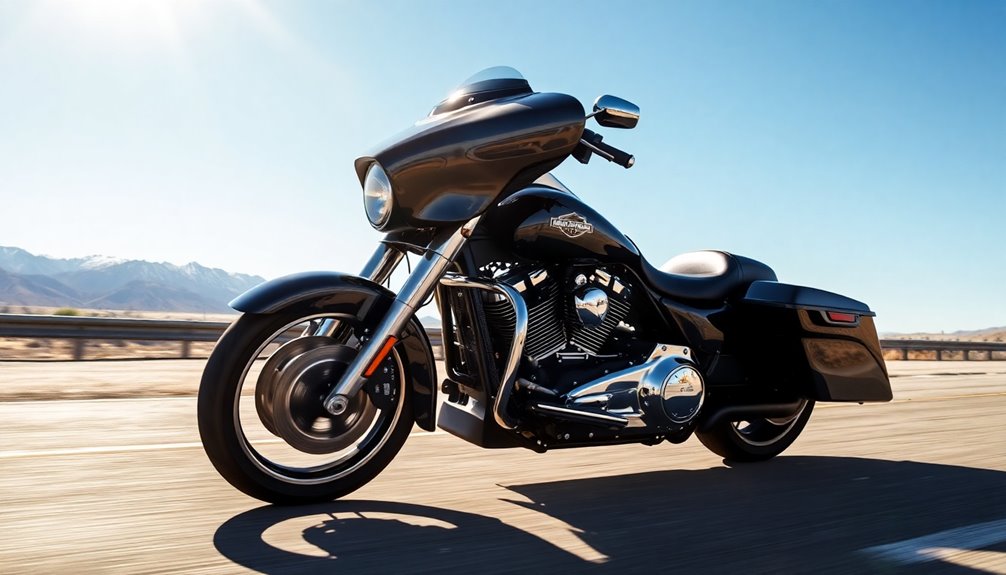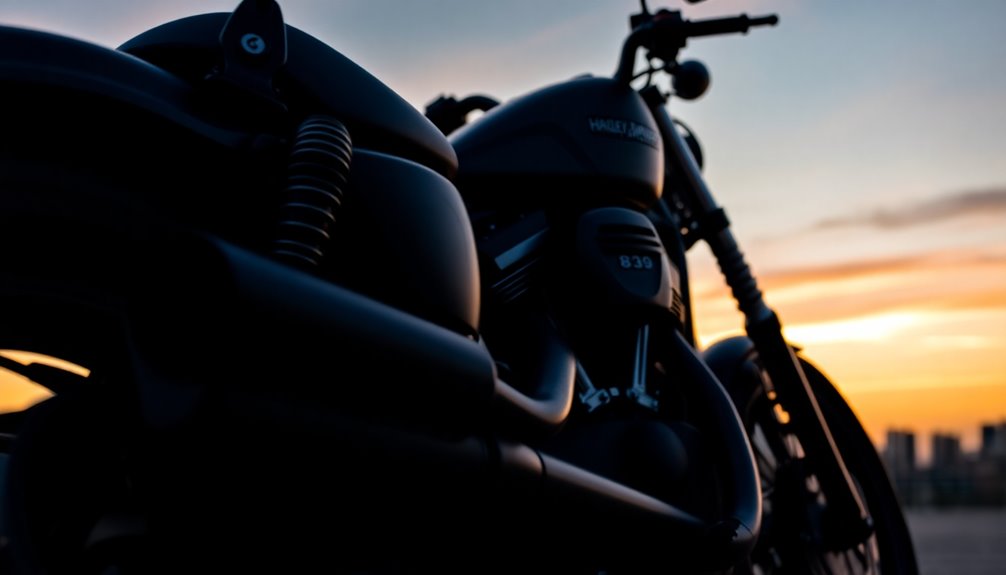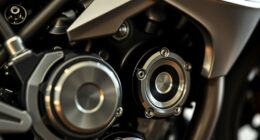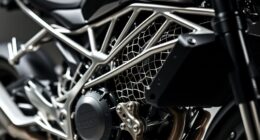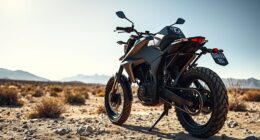The Harley-Davidson Fat Boy combines iconic style with impressive performance, boasting a top speed of 110 mph. Its powerful Milwaukee-Eight 114 engine delivers 93 bhp and 114 lb-ft of torque, ensuring exhilarating rides. Designed with a low center of gravity, it enhances stability while cruising, making it a pleasure to handle. With a low seat height and ergonomic features, you'll enjoy comfort even on long journeys. Known for its timeless American heritage, the Fat Boy appeals to riders who value both nostalgia and modern technology. There's plenty more to explore about this classic powerhouse.
Key Takeaways
- The Harley-Davidson Fat Boy has a maximum speed of 110 mph, showcasing its powerful performance.
- Powered by the Milwaukee-Eight 114 engine, it delivers 93 bhp and 114 lb-ft of torque.
- Its low center of gravity enhances stability, contributing to confident high-speed riding.
- Acceleration from 0-100 kph is achieved in just 4.6 seconds, emphasizing its muscle.
- Aerodynamic design and weight distribution further improve top speed capabilities for exhilarating rides.
Iconic Fat Boy Design
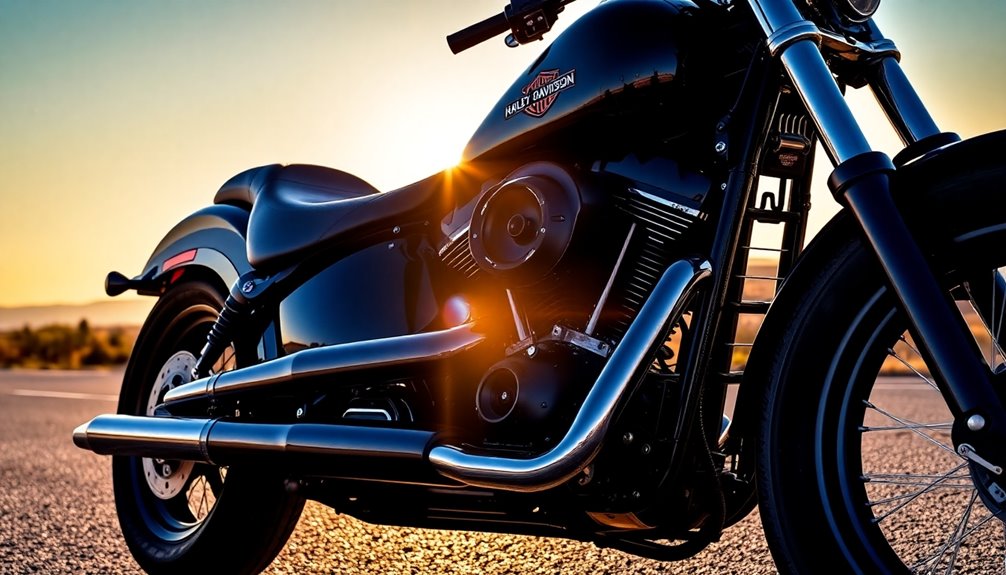
When you first lay eyes on the Harley-Davidson Fat Boy, it's hard not to feel a rush of nostalgia and patriotism. Designed by Willie G. Davidson and Louie Netz, the Fat Boy debuted as a prototype at Daytona Bike Week in 1988 and 1989, with production kicking off in 1990. The name reflects its bulky, muscular appearance, embodying the essence of American motorcycling.
Its distinctive features immediately catch your attention. The solid-cast disc wheels, inspired by steam rollers, give it a bold stance. The solid silver paint and powder-coated frame have earned it the nickname "The Grey Ghost." The Fat Boy is also known for its signature LED forward lighting, enhancing visibility during night rides.
From the wide handlebars to the beefy front fork, every element screams power. The teardrop-shaped fuel tank adds to its classic appeal, while the bold shotgun exhausts and chrome finishes enhance its visual impact.
Under the surface, the Fat Boy has evolved through the years, starting with the Evolution engine and transitioning to the Twin Cam engines. Each update maintains the iconic design while enhancing performance.
Exploring Speed and Handling
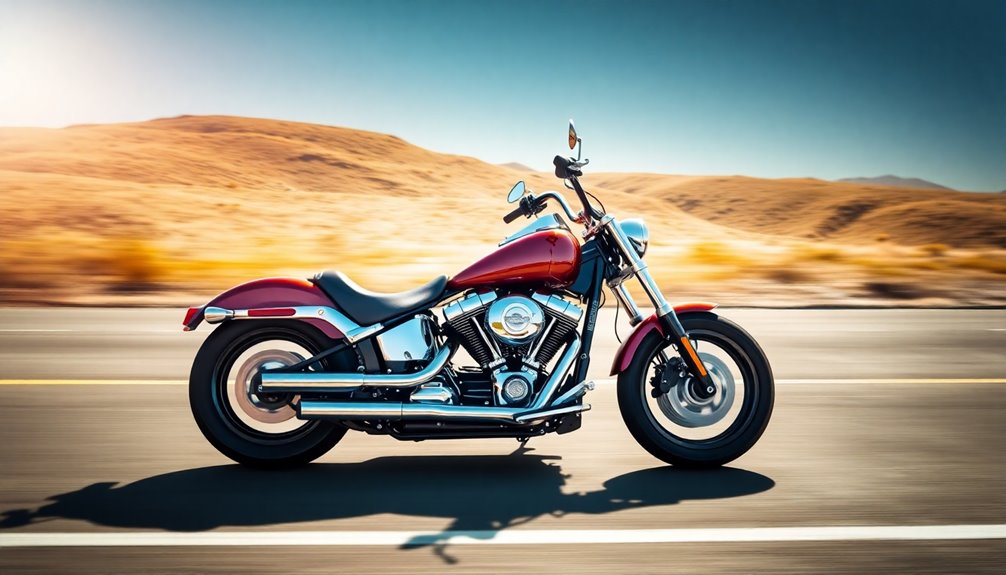
When you hit the throttle on the Harley-Davidson Fat Boy, you'll feel the impressive response that enhances your riding experience.
With a maximum speed of 110 mph and thoughtful aerodynamic design features, this bike is built for both performance and style. The motorcycle is powered by a robust 45° V2 engine, which contributes significantly to its cruiser performance.
You'll appreciate how these elements come together to create a ride that's as exhilarating as it's smooth.
Maximum Speed: 110 Mph
There's no denying that the Harley-Davidson Fat Boy delivers an impressive maximum speed of 110 mph, making it a thrilling choice for those who crave power on the open road.
With the Milwaukee-Eight 114 engine pumping out 93 bhp and 114 lb-ft of torque, you'll experience exhilarating acceleration. This beast can go from 0-100 kph in just 4.6 seconds, showcasing its strong performance right from the get-go.
The bike's design, including its aerodynamics and weight distribution, significantly contributes to achieving that top speed. While the fat rear tire might affect handling at high speeds, it doesn't hinder your ability to hit that thrilling 110 mph. Additionally, some riders have reported that proper tire pressure is essential for maintaining optimal handling while cruising at high speeds.
The electronic throttle control plays a crucial role in managing power delivery, allowing you to maintain stability even when pushing the limits.
On straight roads, the Fat Boy remains steady, handling crosswinds effectively. However, keep in mind that cornering on winding mountain roads can be less agile due to its size and weight.
Ground clearance also limits steep lean angles, so you'll want to navigate those curves with caution. Overall, the Fat Boy's top speed and handling make it a remarkable cruiser for speed enthusiasts.
Throttle Response Improvement
Improving throttle response is crucial for enhancing both speed and handling on your Harley-Davidson Fat Boy. If you're experiencing a delayed or sluggish throttle response, it can undermine your confidence while riding. You might find yourself needing to twist the throttle significantly before the engine reacts, especially in turns, which can be unnerving.
To tackle these issues, start with maintenance. Clean the fuel injectors and ensure the throttle body is free of debris. Regular tune-ups are essential to prevent problems related to the throttle position sensor (TPS) or idle air control valve (IAC). Additionally, keep an eye on the worn-out engine compensator, as this can also impact throttle responsiveness.
If issues persist, consider replacing the TPS with a more reliable unit or upgrading to aftermarket components designed for better throttle response. You can also refine the Electronic Throttle Control (ETC) settings through software adjustments, bringing a crisper feel to your ride.
Mechanical tweaks can mimic the responsiveness of a cable-operated throttle, enhancing your connection with the bike. Lastly, check your primary drive components to ensure everything is in top shape.
Aerodynamic Design Features
Enhancing throttle response not only boosts your riding confidence but also sets the stage for exploring the aerodynamic design features that play a significant role in your Harley-Davidson Fat Boy's speed and handling.
The Fat Boy 114's wide tires, with a 160mm front and a 240mm rear, provide stability at high speeds but can challenge cornering due to their heft. Meanwhile, the bike's distinctive fuel tank and seat design contribute to overall aerodynamics, even if specific benefits aren't detailed. The Fat Boy's low center of gravity enhances your ability to manage its weight during rides.
You'll appreciate the broad handlebars and adjustable footboards for comfort, though they may not be the most aerodynamic. The weight distribution, at a curb weight of 317 kg (698.9 pounds), influences handling as you cruise.
The suspension system, with a front travel of 130 mm and a rear travel of 109 mm, absorbs road irregularities, enhancing stability. However, the 115 mm ground clearance limits lean angles during tight turns.
With a wheelbase of 1665 mm and a rake angle of 32°, the Fat Boy maintains stability, while the trail size of 104 mm ensures responsiveness to your steering input.
Rider Comfort and Ergonomics
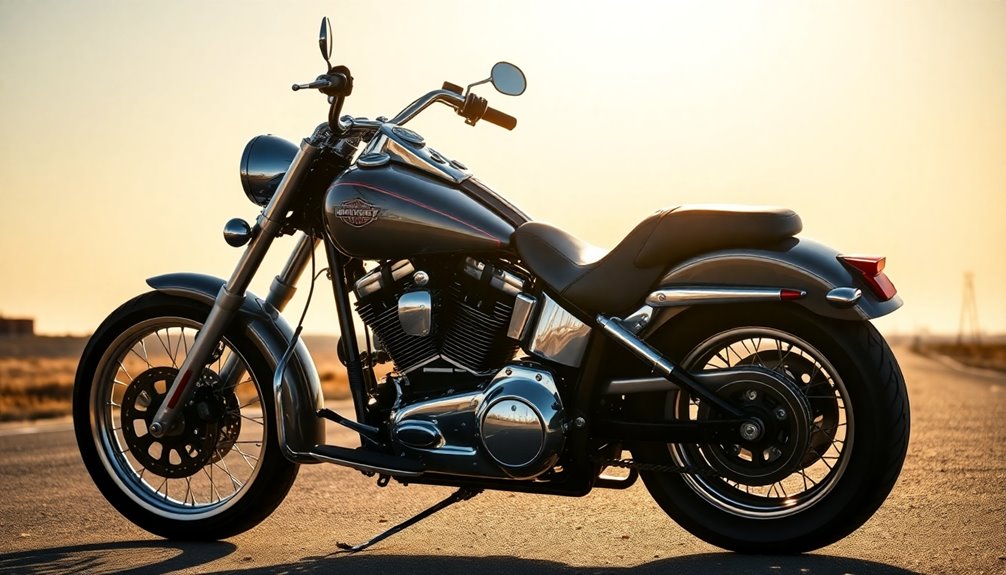
Rider comfort and ergonomics play a crucial role in the experience of riding the 2024 Harley-Davidson Fat Boy 114. With a low seat height of just 25.9 inches, you'll find it easy to plant your feet on the ground. The scooped-up, wider, and flatter two-piece saddle ensures that you're well-supported, making it suitable for longer rides, even if the passenger seat lacks some padding.
If you desire more comfort, the stock seat can be upgraded with aftermarket options like Saddlemen's Explorer.
Your feet will rest comfortably on forward-mounted floorboards, allowing for an optimal riding position that feels just right. You can also adjust the foot control position using extensions or relocator brackets, ensuring that your riding triangle is perfectly tailored to your needs. The adequately sweptback handlebars promote an upright riding posture, reducing strain on your back during long journeys. Combined with advanced suspension technology, the Fat Boy 114 delivers a smooth ride, while ABS gives you the confidence to handle any situation. This bike truly prioritizes your comfort, making every ride an enjoyable experience. Additionally, the Fat Boy 114's maximum torque of 119 ft-lb ensures a powerful acceleration that enhances your comfort during cruising.
Owner Insights: Real Experiences
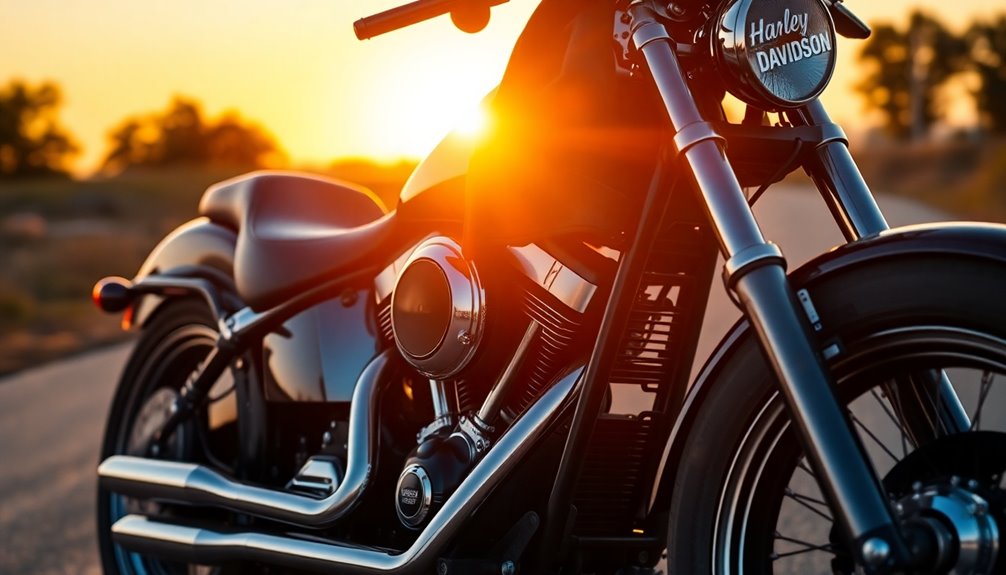
Many owners of the Harley-Davidson Fat Boy 114 rave about their experiences, highlighting the bike's blend of comfort and performance. They appreciate how easily you can handle it despite its weight, thanks to the low center of gravity.
While the wide tires may challenge tight turns, you'll adapt quickly, finding that leaning into turns improves your handling. You might be surprised by how "flickable" it feels compared to other bikes.
Powered by the Milwaukee-Eight 114 engine, the Fat Boy delivers impressive torque and horsepower, making your rides exhilarating. The six-speed transmission allows for a smooth cruising experience, and you'll enjoy a commendable fuel economy of 47 MPG. Additionally, the bike's weight exceeding 300kg contributes to its handling challenges but also adds to its robust presence on the road.
However, be prepared for the engine's heat during stop-and-go traffic.
On the safety front, the bike's 5-inch analog speedometer and optional anti-lock braking enhance your riding confidence. Features like cruise control and a USB port keep you connected on the road.
While the ride experience is raw and thrilling, be mindful of wind resistance on expressways. Overall, the Fat Boy strikes a balance between practicality and the joy of open-road riding, making it a favorite among enthusiasts.
Market Positioning Against Rivals
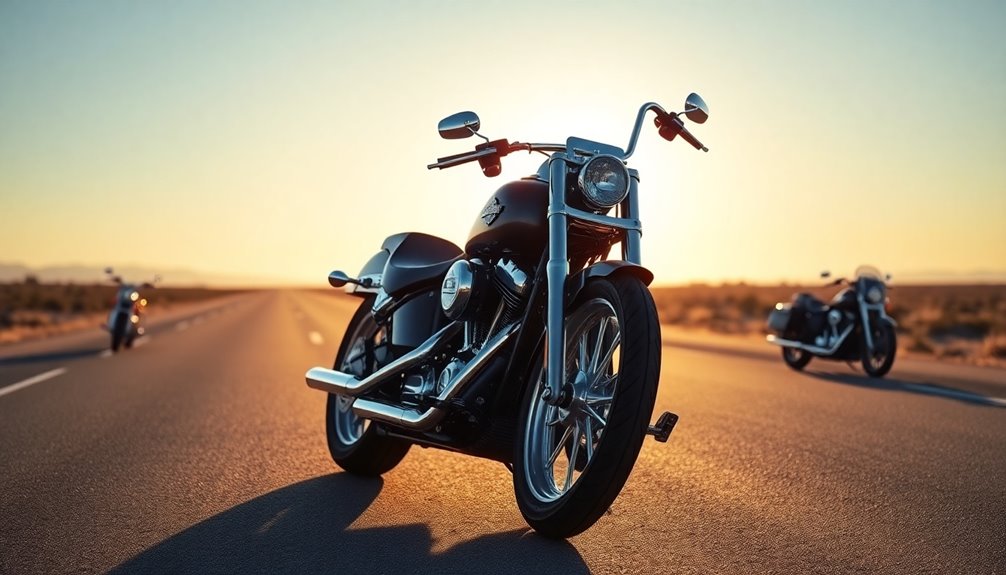
Harley-Davidson consistently navigates a competitive landscape filled with Japanese brands like Honda, Yamaha, and Suzuki, all vying for the attention of younger riders. To maintain its edge, Harley's shifting focus on a broader target market is crucial. By appealing to college-educated working women aged 25 to 54 and expanding internationally, it aims to capture a demographic that values both style and performance. Additionally, merchant account credit processing can streamline payment processes, enhancing customer satisfaction for those purchasing motorcycles and accessories. Furthermore, utilizing emotional triggers in marketing campaigns can significantly strengthen the connection with potential customers seeking a lifestyle brand.
The introduction of lower displacement models like the 750-500cc Sportsters showcases Harley's commitment to diversifying its product line. These bikes, designed for emerging markets in Europe, India, and Japan, cater to a growing preference for lighter, more accessible motorcycles. Additionally, the company is investing $23 million in marketing initiatives to enhance customer interaction and attract new riders. Moreover, risk management strategies are essential for maintaining financial health amid market fluctuations. The focus on energy-efficient technology in their marketing can also appeal to environmentally conscious consumers.
However, the competition remains fierce. Despite Harley's strong brand loyalty, rivals are seizing opportunities due to supply and demand gaps, which could erode Harley's market share. In 1996, Harley held 48.2% of the heavyweight motorcycle market, but as competitors innovate and capture younger audiences, Harley must continually adapt.
With a $23 million marketing budget targeting these new demographics, Harley-Davidson is positioning itself as a formidable contender against rivals—ensuring it stays relevant in a rapidly changing market.
Performance Exhaust Systems
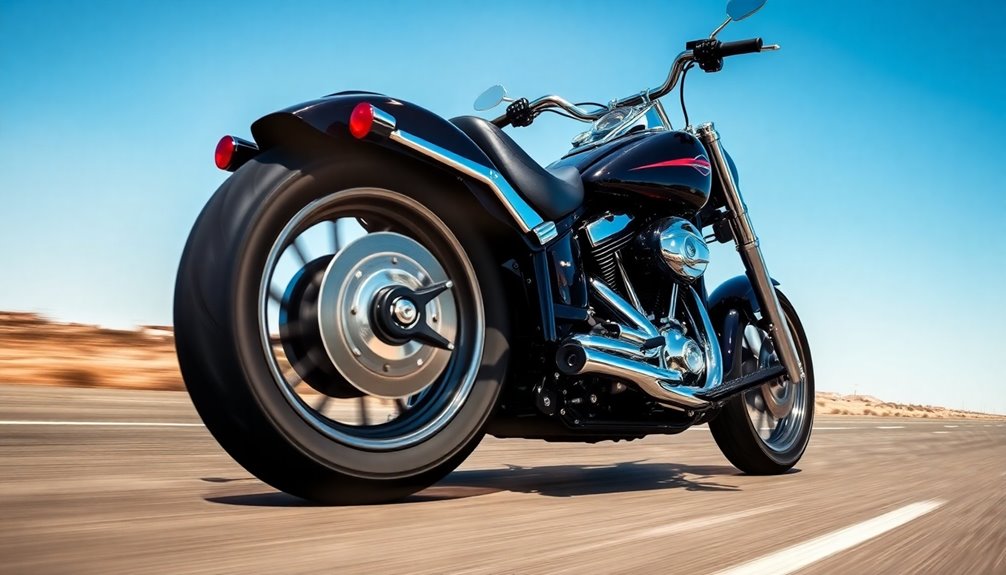
Upgrading your motorcycle's exhaust system can significantly enhance its performance and sound, giving you a more thrilling ride. A popular choice is the 2-Into-1 exhaust system, which improves scavenging efficiency, resulting in increased horsepower and torque. You'll also notice a weight reduction since a single pipe is lighter than dual options. The balanced exhaust flow enhances overall engine performance and can even improve fuel efficiency.
If you want a more comprehensive upgrade, consider a full-system exhaust. This option offers substantial performance improvements over slip-ons, with redesigned components like headers and mid-pipes that optimize exhaust flow. Changing rear belt pulleys can also be an effective performance upgrade when paired with the right exhaust system.
Lightweight materials further boost your bike's power-to-weight ratio. For specific recommendations, the Rush Wrath 2:1 exhaust system is an excellent choice, starting with a 2.5" baffle. If you prefer aesthetics, the Cobra 909 2 into 2 offers both style and performance.
Don't forget that switching exhaust systems may require tuning adjustments, especially if you're planning other engine modifications. Always consult with experts to ensure compatibility and compliance with regulations, ensuring you get the best performance possible from your Harley-Davidson Fat Boy.
Cost and Dealer Locations

When you're ready to hit the road on a 2024 Harley-Davidson Fat Boy 114, it's important to know the costs involved and where to find a dealer. The base price starts at $21,999, but if you want color options, be prepared to spend a bit more: $350 for Vivid Black, $525 for Premium Color, and $650 for Premium Plus Color.
Don't forget the additional fees like California emissions ($200) and freight ($700). If you're considering a used model, options like the 2018 Fat Boy 114 for $14,995 or the 2017 FAT BOY LO Screaming Eagle 110 for $11,250 could be appealing.
For dealer locations, check out Farrow Harley-Davidson with two locations in Ohio: Sunbury (7754 OH-37, 740-965-9900) and Columbus (5840 Scarborough Blvd, 614-836-6330). They offer a range of new and used models, parts, and services. You can also explore Country Roads Harley-Davidson or browse Cycle Trader listings for private sellers across the U.S.
With multiple options available, finding your dream Fat Boy is easier than ever! The 2018 Harley-Davidson Fat Boy 114 is a powerful and stylish cruiser motorcycle that many riders admire.
Luxury Motorcycle Enthusiasts
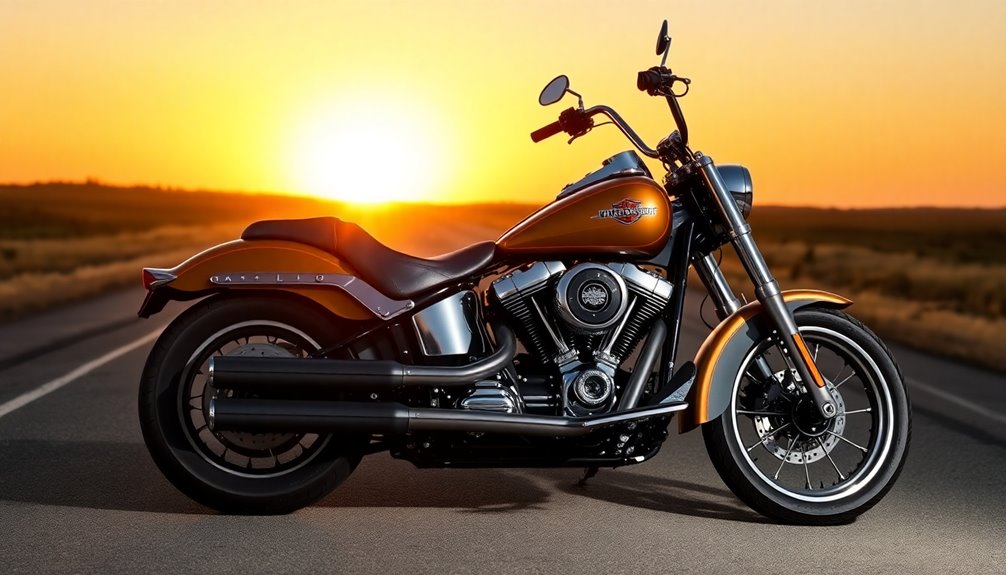
For those who appreciate the finer details of motorcycling, the 2024 Harley-Davidson Fat Boy 114 embodies luxury and performance.
As a luxury motorcycle enthusiast, you understand that riding is about more than just reaching a destination; it's about savoring the journey. With the Milwaukee-Eight 114 engine, you'll enjoy the thrilling rumble and smooth acceleration that define your weekend escapes from the daily grind. The Fat Boy's advanced suspension technology ensures a comfortable ride, whether you're taking a scenic route or embarking on a longer adventure. You'll appreciate the Electronic Sequential Port Fuel Injection, providing precise throttle response that enhances your riding experience. This bike exemplifies the brand's commitment to iconic American style, making it a true representation of Harley-Davidson's heritage.
The bike's bright chrome finishes and bold design not only turn heads but also reflect your personal style and love for craftsmanship.
In this community of riders, individualism and freedom reign supreme. You share stories with fellow enthusiasts, bonding over the unforgettable experiences that only a Harley can deliver.
Embracing self-sufficiency and adaptability, you know that your motorcycle is more than just a machine; it's a key to adventure and relaxation, inviting you to unwind while embracing the open road.
Frequent Tire Wear Concerns
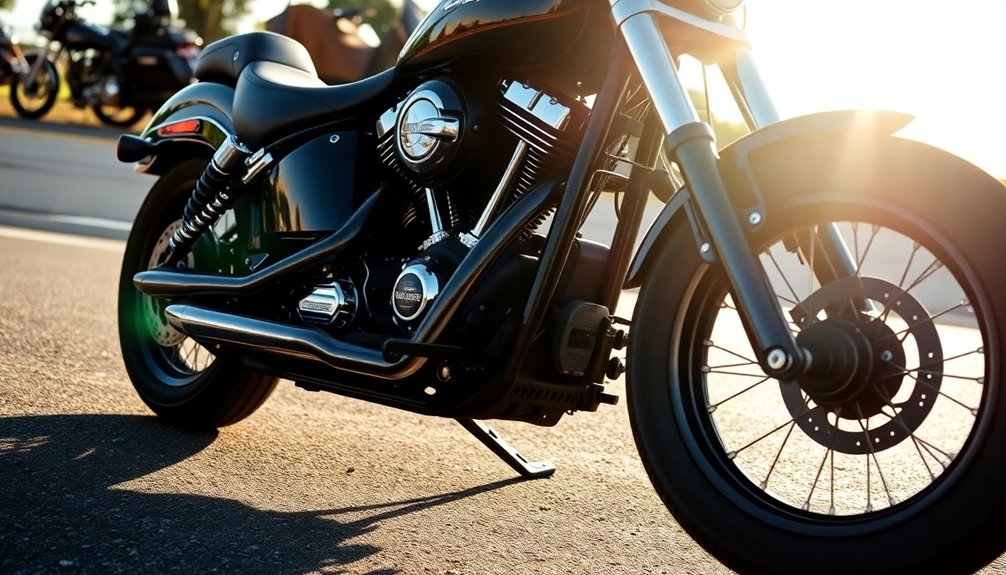
How can you ensure your Harley-Davidson Fat Boy maintains optimal performance and safety? One major concern is frequent tire wear. You might notice uneven wear patterns, especially in the center of the rear tire or on one side of the front tire.
The wide tires on your Fat Boy can exacerbate this issue, leading to shorter tire life and potential replacements sooner than expected. To combat this, keeping an eye on tire pressure is crucial. Regular checks are vital as daily PSI loss noted by some riders can contribute to rapid wear.
Underinflation or overinflation can accelerate wear, so check your tire pressure weekly—aim for around 36 psi in the front and 42 psi in the rear. Your riding style also plays a part; aggressive braking or riding two-up can impact how your tires wear.
Don't forget to regularly inspect your tires for signs of wear, cracking, or bulging. If you're looking for alternatives, consider tires like the Dunlop D407 or Michelin Commander II for better mileage.
Consulting with a Harley-Davidson dealership or mechanic can help pinpoint specific issues related to your tire wear, ensuring you enjoy a smooth ride without unnecessary interruptions.
Enhanced Braking Systems
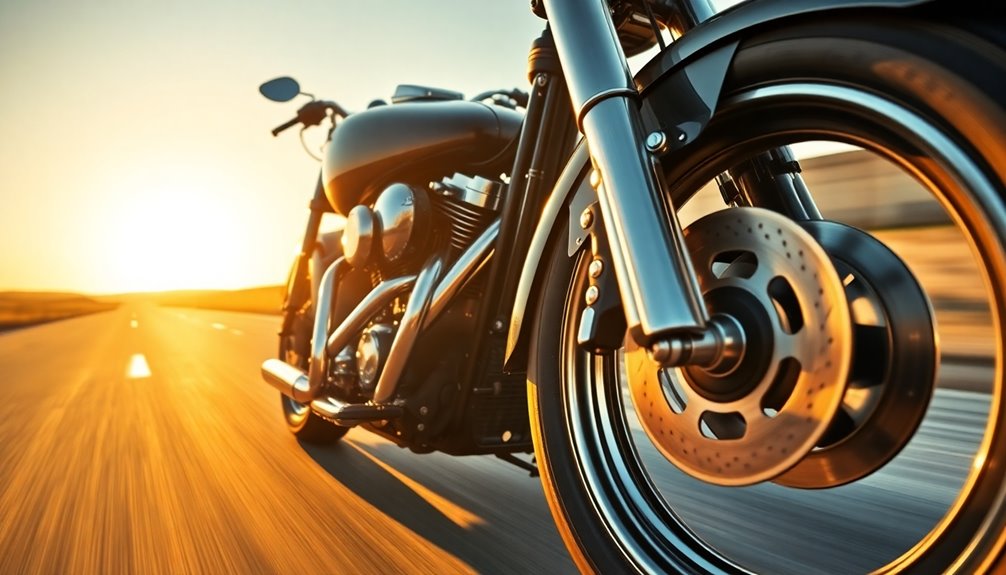
Enhanced braking systems on the Harley-Davidson Fat Boy provide riders with a significant boost in safety and control. The Anti-Lock Braking System (ABS) prevents wheel lockups during sudden stops by monitoring brake pressure and wheel speed. You'll feel a slight pulsing in the hand lever or rear pedal when ABS activates, ensuring maximum control. Depending on the model, ABS may come standard or as an option. This system is designed to prevent wheel lockup during emergency braking situations.
For those who enjoy cornering, the Cornering Enhanced Antilock Braking System (C-ABS) adds another layer of safety. This system adapts brake pressure based on your bike's lean angle, helping maintain stability even when you're leaning into a turn.
Additionally, the Electronically Linked Braking (ELB) technology, part of the Reflex Defensive Rider Systems (RDRS), enhances braking balance by linking the front and rear brakes electronically. This feature is especially useful in low-traction conditions, ensuring you stay safe in various riding scenarios.
Lastly, the Fat Boy 114 includes other safety features like Drag-Torque Slip Control (DSCS), which reduces excessive rear-wheel slip during deceleration.
These advanced braking systems make your ride smoother and more secure, allowing you to focus on the road ahead.
Timeless American Motorcycle Heritage
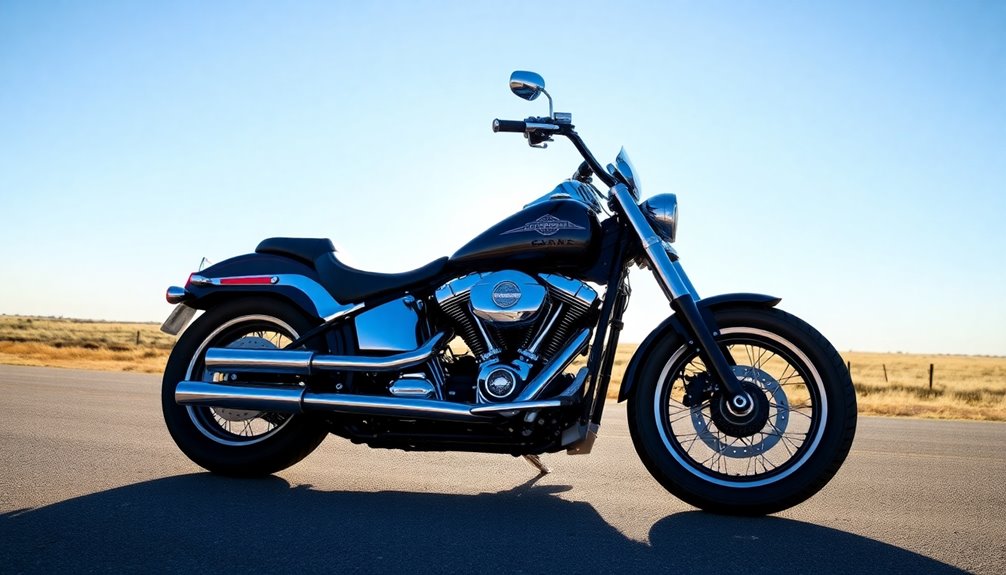
The Harley-Davidson Fat Boy exemplifies timeless American motorcycle heritage, seamlessly blending classic design with modern performance. Originally crafted by Willie G. Davidson and Lou Ness, the Fat Boy made its debut during the Daytona Bike Week rallies in the late 1980s. Its name, often linked to the atomic bombs, actually reflects the bike's robust stature.
As part of the Softail series, it carries forward Harley's legacy with iconic elements like the 'beer can' covers on the front forks. This motorcycle represents a significant evolution in Harley-Davidson's lineup. The Fat Boy 114, with its displacement of 1868 cc, now boasts the Milwaukee-Eight™ 114 engine, offering impressive torque and horsepower. The transition to a modern Softail frame in 2018 enhanced its ride comfort while maintaining the classic cruiser design that riders adore.
Culturally, the Fat Boy symbolizes freedom and adventure, making it a staple in the cruiser motorcycle community. Its blend of vintage aesthetics and cutting-edge technology not only turns heads but also solidifies its place in the hearts of enthusiasts.
Riding a Fat Boy means embracing a cherished piece of American motorcycle history.
Frequently Asked Questions
What Is the Horsepower of the Harley-Davidson Fat Boy?
When you're curious about the horsepower of the Harley-Davidson Fat Boy, you'll find that the 2024 model boasts an impressive 94 HP at 4,750 rpm.
This powerful engine allows for a thrilling ride, providing the classic muscle feel that Harley enthusiasts crave.
While the 2014 model doesn't specify horsepower, it's clear that the newer version enhances performance significantly.
How Does the Fat Boy Compare to Other Touring Bikes?
When you compare the Fat Boy to other touring bikes, you'll notice it excels in style and performance.
Its powerful 94 HP engine offers impressive torque, making acceleration smooth and enjoyable.
While some touring bikes focus on comfort, the Fat Boy balances aesthetics and functionality, with a lower seat height and wide tires for stability.
You'll appreciate the blend of classic design and modern technology, enhancing your riding experience on long journeys.
What Is the Weight of the Harley-Davidson Fat Boy?
The Harley-Davidson Fat Boy weighs 317 kg, or about 699 lbs when wet. This includes the motorcycle's kerb weight, which is crucial for understanding its handling and performance.
The dry weight stands at 304 kg, reflecting the bike without fluids. With a Gross Vehicle Weight Rating (GVWR) of 571 kg, it accommodates the rider, passenger, and cargo.
This weight balances power and stability, making your ride both thrilling and manageable.
Are There Any Special Editions of the Fat Boy?
Yes, there are special editions of the Fat Boy.
You can find the 30th Anniversary Edition, which features a limited production run of 2,500 units, complete with a blacked-out Milwaukee-Eight 114 engine and unique bronze highlights.
There's also the 120th Anniversary Edition, showcasing bright chrome finishes and a powerful V-Twin engine.
Both models incorporate exclusive design elements that set them apart from the standard Fat Boy, enhancing their appeal and collectibility.
What Type of Oil Should I Use for Maintenance?
For maintenance, you should use 20W-50 oil, preferably synthetic or semi-synthetic, as it offers better heat tolerance and lubrication for your engine.
Brands like Harley-Davidson's own oil or Amsoil are great options.
Make sure to check your oil level regularly and fill it just below the max to prevent overflow.
Always consult your owner's manual for specific recommendations related to your model to keep your bike running smoothly.
